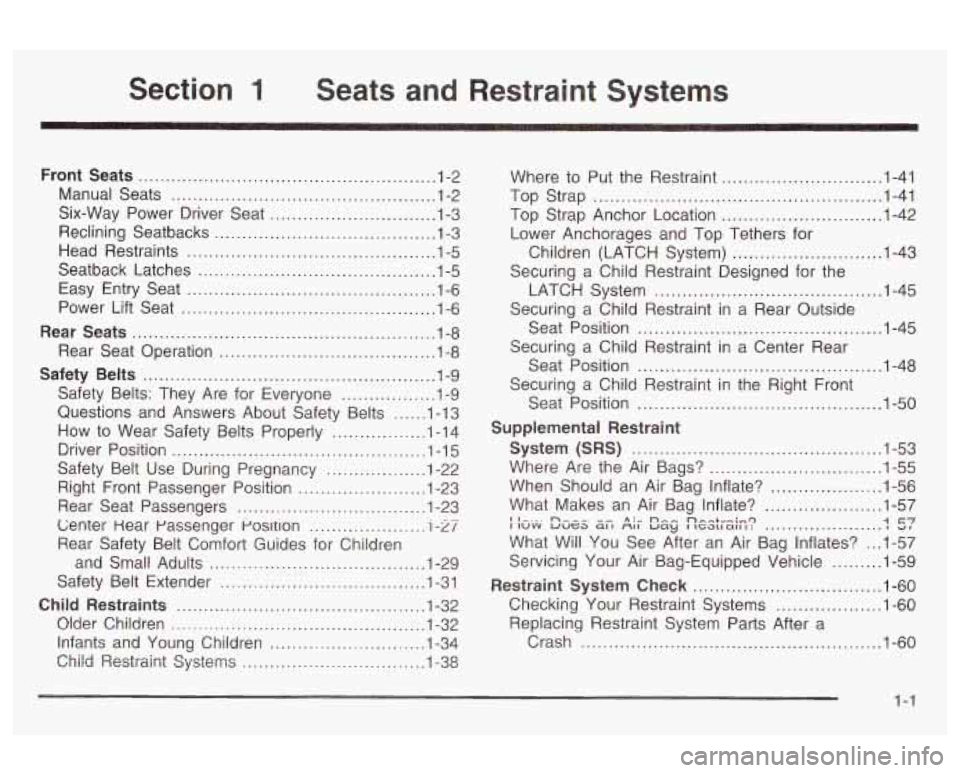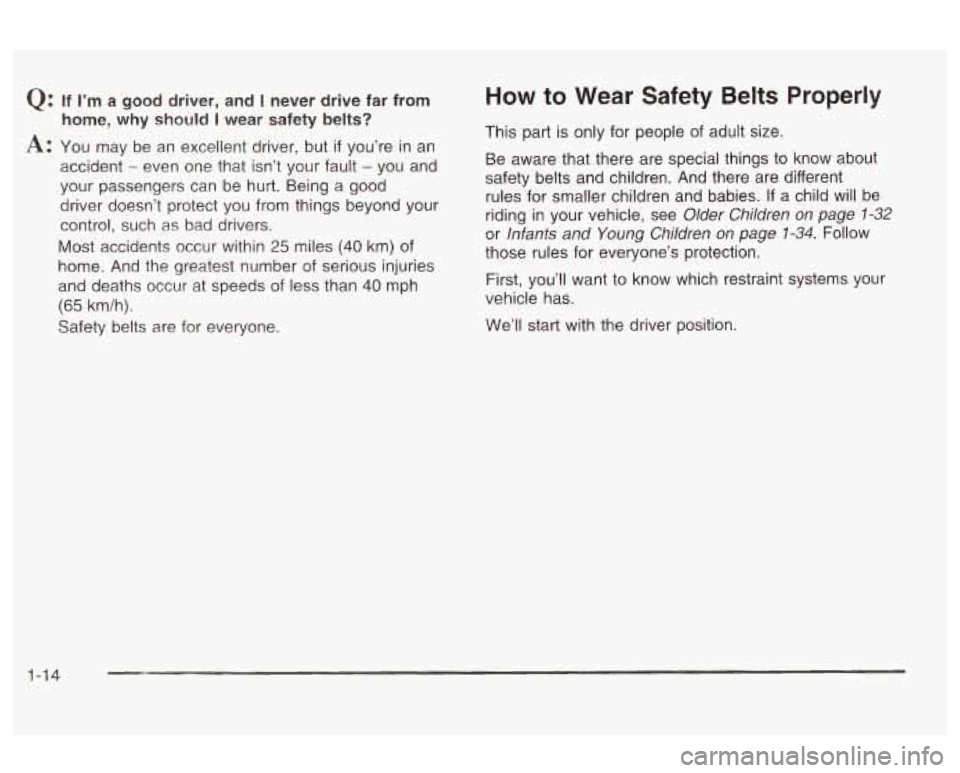2003 Oldsmobile Alero belt
[x] Cancel search: beltPage 2 of 354

The 2003 Oldsmobile Alero Owner Manual a
Seats and Restraint Systems ........................... 1-1
Front Seats
............................................... 1-2
Rear Seats
............................................... 1-8
Safety Belts
.............................................. 1-9
Child Restraints
....................................... 1-32
Supplemental Restraint System (SRS)
...................................... 1-53
Restraint System Check
............................ 1-60
Keys
........................................................ 2-2
Doors and Locks
....................................... 2-7
Windows
................................................. 2-1 4
Theft-Deterrent Systems ............................ 2-1 6
Starting and Operating Your Vehicle
........... 2-17
Mirrors
.................................................... 2-32
Siorage Areas
......................................... 2-34
Sunroof .................................................. 2-35
Instrument Panel Overview
.......................... 3-4
Climate Controls
...................................... 3-1 9
.w .arning Lights, Gages and indicators ......... 3-23
Audio System(s) ....................................... 3-38
Features and Controls
..................................... 2-1
Instrument Panel
............................................. 3-1 Driving Your Vehicle
....................................... 4-1
Your Driving, the Road, and Your Vehicle
..... 4-2
Towing
................................................... 4-31
Service
..................................................... 5-3
Fuel ......................................................... 5-5
Checking Things Under
the
Hood ............................................... 5-9
Headlamp Aiming
..................................... 5-47
Bulb Replacement .................................... 5-49
Windshield Wiper Blade Replacement
......... 5-52
Tires
...................................................... 5-53
Appearance Care
..................................... 5-72
Vehicle Identification
................................. 5-80
Electrical System
...................................... 5-81
Zapai;iiit=s at-tii ~J~LIIIL~LIUI I> 5-w~
Normal Maintenance Replacement Parts ...... 5-88
Maintenance Schedule ........................... ... 6-1
Maintenance Schedule
................................ 6-2
Customer Assistance Information
.................... 7-1
Customer
Assistance iniorrnation .................. 7-2
Index ................................................................. 1
Service
and Appearance Care
.......................... 5-1
n.- - -:I: - -1: - .- - .....................
Page 6 of 354

These are some examples of vehicle symbols you may find on your vehicle:
POSSIBLE A
CAUTION
INJURY
PROTECT EYES BY
SHIELDING
CAUSTIC
BATTERY
ACID COULD CAUSE
BURNS
AVO1 D
1 SPARKS OR
1 FLAMES
1 BATTERY LATCH BOTH LAP AND
SHOULDER BELTS TO
PROTECT OCCUPANT
48: @
DO NOT TWIST SAFETY
BELT WHEN ATTACHING
FASTEN SEAT
BELTS
MOVE SEAT FULLY
\!$
REARWARD+ /z
SECURE
CHILD SEAT
PULL BELT
COMPLETELY
THEN SECURE CHILD SEAT
I
1
DO NOT INSTALL
A REAR-FACING
CHILD RESTRAINT IN THIS SEATING
POSITION
DO NOT INSTALL A
'ORWARD-FACING CHILD RESTRAINT
IN THIS SEATING
POSITION
--,.-. ,.,.,, a uvun Luun
UNLOCK JGHTING
- MASTER SWITCH B- / ,
SIGNALS @+
TURN
PARKING
pf
LAMPS
DAYTIME
**a
RUNNING y.:
LAMPS 0
ENGINE
COOLANT TEMP
CHARGING
I-]
BATTERY SYSTEM
COOLANT
d
ENGINE OIL
PRESSURE
Wb
ENGINE
COOLANT FAN
OWNERS MANUAL
SERVICE
SFRVICF
MANUAL
V
Page 8 of 354

Section 1 Seats and Restraint Systems
Front Seats .......................... ...... 1-2
Manual Seats
............................... ...... 1-2
Six-Way Power Driver Seat
............. , ......... 1-3
Reclining Seatbacks
........................................ 1-3
Head Restraints
............................................. 1-5
Seatback Latches ........................................... 1-5
Easy Entry Seat
............................................. 1-6
Power Lift Seat
.............................................. 1-6
Rear Seats
...................................................... .l -8
Rear Seat Operation ....... ........................ -1 -8
Safety Belts
..................................................... 1-9
Safety Belts: They Are for Everyone
................. 1-9
Questions and Answers About Safety Belts
...... 1-13
How to Wear Safety Belts Properly
................. 1-14
Driver Position
.............................................. 1-1 5
Safety Belt Use During Pregnancy .................. 1-22
Right Front Passenger Position
....................... 1-23
Rear Seat Passengers
.................................. 1-23
Lenter Hear passenger Posltion
i -z
Rear Safety Belt Comfort Guides for Children
_I .....................
and Small Adults ....................................... 1-29
Safety Belt Extender
..................................... 1-31
Child Restraints
............................................. 1-32
OIder Children .............................................. 1-32
Infants and Young Children
............................ 1-34
Child Restraint Systems
................................. 1-38 Where
to Put the Restraint
........ ...... 1-41
Top Strap
................................................ -1 -41
Top Strap Anchor Location
............................. 1-42
Children (LATCH System)
........................... 1-43
Lower Anchorages
and Top Tethers for
Securing a Child Restraint Designed for the
Securing
a Child Restraint in a Rear Outside
Securing a Child Restraint in a Center Rear
Securing a Child Restraint in the Right Front
LATCH System
......................................... 1-45
Seat Position
............................................ 1-45
Seat Position
............................................ 1-48
Seat Position
......................................... 1-50
Supplemental Restraint System (SRS)
............................................. 1-53
Where Are the Air Bags?
............................... 1-55
When Should an Air Bag Inflate?
.................... 1-56
What Makes an Air Bag Inflate?
..................... 1-57
What Will You See After an Air Bag Inflates?
... 1-57
Servicing Your Air Bag-Equipped Vehicle
......... 1-59
I I - ... n--- -- n., ne- n-e4v-:-q I IUVV uut;a a1 I r\ll uay 1ca11all I : ..................... 157
Restraint System Check .................................. 1-60
Checking Your Restraint Systems ................... 1-60
Replacing Restraint System Parts After
a
Crash ...................................................... 1 -60
1-1
Page 11 of 354

But don’t have a seatback reclined if your vehicle is
moving. Sitting
in a
reclined position when your vehic
is in motion can be dangerous. Even if you
buckle up, your safety belts can’t do their job
when you’re reclined like this.
The shoulder belt can’t do
its job because it
won’t be against your body. Instead, it will be
in front
of you. In a crash you could go into it,
receiving neck or other injuries.
The lap belt can’t do it’s job either. In
a crash
the belt could go up over your abdomen. The
belt forces would be there, not at your pelvic
bones. This could cause serious internal
injuries.
For proper protection when the vehicle is
in
motion, have the seatback upright. Then sit
well back in the seat and wear your safety belt
properly.
1 -4
Page 16 of 354

Safety Belts
Safety Belts: They Are for Everyone
This part of the manual tells you how to use safety
belts properly. It also tells you some things you should
not do with safety belts.
Don’t let anyone ride where he or she can’t
wear
a safety belt properly. If you are in a
crash and you’re not wearing a safety belt,
your injuries can be much worse. You can hit
things inside the vehicle
or be ejected from it.
You can be seriously injured or killed. In the
same crash, you might not be, if you are
buckled up. Always fasten your safety belt,
fastened properly too.
2!?d check fhll p.!1 p2ssenCJerr’ he!fs arc?
It is extremely dangerous to ride in a cargo
area, inside or outside of a vehicle.
In a
collision, people riding in these areas are more
likely to be seriously injured or killed.
Do not
allow people to ride in any area of your vehicle
that
is not equipped with seats and safety
belts. Be sure everyone in your vehicle
is in a
seat and using a safety belt properly.
1-9
Page 17 of 354

Your vehicle has a light
that comes on as a
reminder to buckle up. See
Safety Belt Reminder
Light on page
3-26.
In most states and in all Canadian provinces, the law
says to wear safety belts. Here’s why:
They work.
You never know if you’ll be in a crash. If you do have a
crash, you don’t know
if it will be a bad one.
A few crashes are mild, and some crashes can be
so
serious that even buckled up, a person wouldn’t survive.
But most crashes are in between. In many of them,
people who buckle up can survive and sometimes walk
away. Without belts they could have been badly hurt or killed.
After more than
30 years of safety belts in vehicles, the
facts are clear. In most crashes buckling up does
matter
... a lot!
Why Safety Belts Work
When you ride in or on anything, you go as fast as
it goes.
Take the simplest vehicle. Suppose it’s just a seat on
wheels.
1-10
Page 20 of 354

or the safety belts!
With safety belts, you slow down as the vehicle does.
y01-1 cpt mnre time tn stop Yo11 stop over more distance:
and your strongest bones take the forces. That’s why
safety belts make such good sense.
Questions and Answers About
Safety Belts
Q: Won’t I be trapped in the vehicle after an
accident if I’m wearing a safety belt?
A: You could be - whether you’re wearing a safety
belt or not. But you can unbuckle a safety belt,
even
if you’re upside down. And your chance
of being conscious during and after an accident, so
you can unbuckle and get out, is much greater if
you are belted.
Q: If my vehicle has air bags, why should I have to
wear safety belts?
A: Air bags are in many vehicles today and will be in
most of them in the future. But they are
supplemental systems only;
so they work with
system ever offered for sale has required the use of
safety belts. Even if you’re in a vehicle that has
air bags,
you still have to buckle up to get the most
protection. That’s true not only in frontal collisions,
saieiy beiis - rlui ir-lsieaii UI LII~ITI. CVCI y all uay C&I-- r -:..I---
but especia!!y in side and other co!lMQnsl
1-13
Page 21 of 354

Q: If I’m a good driver, and I never drive far from
home, why should
I wear safety belts?
A: You may be an excellent driver, but if you’re in an
accident
- even one that isn’t your fault - you and
your passengers can be hurt. Being a good
driver doesn’t protect you from things beyond your
control, such
as bad drivers.
Most accidents occur within 25 miles (40 km) of
home. And the greatest number of serious injuries
and deaths occur at speeds of less than
40 mph
(65 km/h).
Safety belts are for everyone.
How to Wear Safety Belts Properly
This part is only for people of adult size.
Be aware that there are special things
to know about
safety belts and children. And there are different
rules for smaller children and babies.
If a child will be
riding in your vehicle, see
Older Children on page 7-32
or Infants and Young Children on page 7-34. Follow
those rules for everyone’s protection.
First, you’ll want
to know which restraint systems your
vehicle has.
We’ll start with the driver position.
1-14